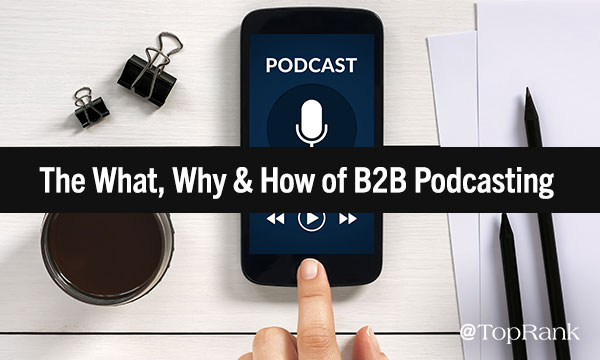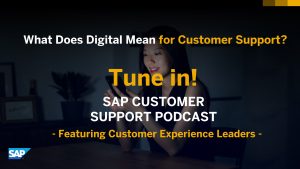
Okay, B2B marketers, time for a pop quiz:
- Which content marketing tactic can hold an audience’s attention for a half hour or more at a time?
- Which tactic inspires an audience to subscribe to your content and make a regular appointment to consume it?
- Which tactic can help boost thought leadership, raise awareness and engage influencers in your industry?
- Which tactic is in the title of this blog post?
The answer, of course, is podcasting. These long-form audio programs first emerged in the early 2000s. Back then, they were a niche format for hobbyists and tech nerds (like me). But the rise of the smartphone brought podcasts to the masses. Now, there are hundreds of hours of programming available on every conceivable subject, in every genre from true crime to horror to musical. But we haven’t hit content shock for podcasts — it’s still a growing market.
If your brand is looking to boost thought leadership and reach a new audience, now is the perfect time to add a podcast to your content marketing mix. Here’s what you need to know to get started.
What Is a Podcast, Anyway?
There’s a wide variety of types of podcast out there, so it can seem tricky to find a definition that covers everything. Some are live interviews or panel discussions; some are fully scripted and produced audio plays; some are cryptic monologues about a bizarre southwestern town. But they all share two attributes:
- There are multiple recordings for each title, and
- They’re organized in an RSS feed you can subscribe to.
Whatever genre the audio is, whatever platforms it’s available on, as long as you have multiple recordings brought together by an RSS feed, you have a podcast.
Why Should B2B Content Marketers Care about Podcasts?
The way that people consume podcasts make them an ideal channel for your high-quality content. People tend to listen while working out, driving, cooking dinner — in other words, podcasts fill sizable chunks of otherwise idle time. You wouldn’t expect someone to read your white paper or eBook during their morning commute, but they might settle in with your latest episode.
The demographics for podcast listeners are attractive for B2B marketers, too. Edison Research’s Podcast Consumer 2017 report found that:
- 24% of people ages 18-54 listen to podcasts monthly
- Podcast listeners are almost evenly split between men and women
- Podcast listeners tend to be affluent, educated consumers
- In the 25-54 demographic, monthly listening has grown year over year for the past four years
In other words, your target audience is likely spending a significant amount of time listening to podcasts already. And those who already listen to at least one podcast are likely to be on the lookout for more.
What Marketing Goals Can a B2B Podcast Serve?
Podcasts work best for the attract and engage phases of the customer journey. You can use your podcast to build brand awareness and establish thought leadership in your industry. Thoughtful, valuable content can help your brand stand out from the competition, and encourage listeners to build a relationship with the brand.
The most successful B2B podcasts tend to be in the Q&A or panel discussion style. Hosts can welcome new guests each week to share their insight. This type of format is perfect for influencer marketing: You can boost your internal subject matter experts, form relationships with influencers in the industry, even feature your potential prospects.
The Dell Luminaries* podcast is a great example of thought leadership B2B podcasting. Each episode features a guest with useful — and often fascinating — thoughts to share with the audience. Some guests are internal experts at Dell, while others are influential entrepreneurs and executives from across the tech industry.

Since podcasts have a low barrier of entry, they’re a good way to reach a niche audience, too. SAP’s recently-launched Customer Support Podcast * is a worthy example. Each episode features quotes from a wide array of influencers, internal and external.

These podcasts succeed because they do what all great content does: deliver valuable information to a specific audience in an entertaining format.
How Do I Get Started?
It’s never been easier to launch a podcast. There are dozens of free and low-priced tools available to streamline every part of production, from recording to amplification. Here’s a quick rundown.
#1: Recording
To start recording, all you really need is a laptop and a decent-quality USB microphone. We get professional-sounding results with a Blue Yeti. For my personal podcast, I use an MXL 770. Either are more than adequate to get you started. Later you can invest in a whole sound studio’s worth of mixing boards, microphones, and accessories if you like, but start simple.
If you plan to interview guests on the show, likely you will be recording remotely over Skype, Google Hangout, or another VOIP. Don’t try to record your guest’s audio through your computer speakers or phone; have them create their own recording on their end, then edit the conversation together. We’ve been experimenting with Zencastr, which handles recording and VOIP coordination automatically, and have been pleased with the results.
For recording software, Audacity is still the best entry-level program. It’s free, has a host of useful features, and you don’t have to be a sound engineer to get great audio.
#2: Syndication
Once your audio is recorded and edited, you need a place to host the file, and an RSS feed to submit to podcast directories. You can host the files locally and create your own RSS feed in raw html, but there are plenty of free-to-cheap platforms that can handle the grunt work. Most use an uploading interface similar to publishing on WordPress. So if you know how to upload a blog, you can create a podcast feed.
We have had good results with both Libsyn and Podbean. Both have free options and inexpensive paid plans with a few added features, and both provide stats that can help you track listenership.
Most importantly, they both will walk you through the process of listing your podcast on various directories: Google Play, iTunes, Stitcher, Spotify, and more. That’s a crucial step in making sure your podcast is available on your audience’s preferred listening platform.
#3: Amplification
Once your podcast is published, there are a few easy ways to get the word out and start building your audience. First, activate your existing blog audience: Post a blog post for each episode with the audio embedded (Libsyn and Podbean both enable live-streaming embedded audio). Include an optimized title and meta description and a transcript or SEO-optimized introduction. And, of course, make sure to include a call to action to subscribe!
If your podcast includes influencers, create social media assets for them to share, including messaging and custom images. Share the podcast on your social channels as well, making sure to tag your influencers.
Cast Your Pods to the Wind
Podcasts are a rare type of content marketing: Interest in them is steadily growing, people go out of their way to seek out new content, and they’re relatively cheap and easy to produce. B2B marketers are constantly challenged to deliver the right content to people in the right format to earn their attention. If your target audience has a morning commute, a workout schedule, or other quiet time to fill, your podcast may be just what they’re waiting for.
Try these 10 marketing podcasts to make your own free time more productive.
*Dell and SAP are TopRank Marketing clients.

Comments are Closed